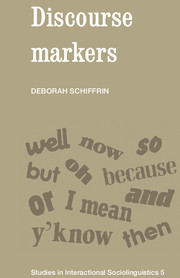Book contents
- Frontmatter
- Contents
- Acknowledgements
- Intonation and transcription conventions
- 1 Background: What is discourse?
- 2 Prelude to analysis: Definitions and data
- 3 Questions: Why analyze discourse markers?
- 4 Oh: Marker of information management
- 5 Well: Marker of response
- 6 Discourse connectives: and, but, or
- 7 So and because: Markers of cause and result
- 8 Temporal adverbs: now and then
- 9 Information and participation: y'know and I mean
- 10 Discourse markers: Contextual coordinates of talk
- Notes
- References
- Author index
- Subject index
5 - Well: Marker of response
Published online by Cambridge University Press: 05 June 2012
- Frontmatter
- Contents
- Acknowledgements
- Intonation and transcription conventions
- 1 Background: What is discourse?
- 2 Prelude to analysis: Definitions and data
- 3 Questions: Why analyze discourse markers?
- 4 Oh: Marker of information management
- 5 Well: Marker of response
- 6 Discourse connectives: and, but, or
- 7 So and because: Markers of cause and result
- 8 Temporal adverbs: now and then
- 9 Information and participation: y'know and I mean
- 10 Discourse markers: Contextual coordinates of talk
- Notes
- References
- Author index
- Subject index
Summary
Like oh, use of well is not based on semantic meaning or grammatical status. Although well sometimes is a noun, an adverb, or a degree word, its use in utterance initial position is difficult to characterize in terms based on any of these classes. Rather, it has been labelled interjection, filler, particle, hesitator, and initiator (Svartvik 1980).
Sacks, Schegloff and Jefferson (1974) observe that well often begins turns. Like other turn-initiators, well reveals little about the construction of the upcoming turn – an important feature as turn-beginnings may overlap prior turns and thus be partially unanalyzable by those to whom the turn is addressed. At more global levels of conversational organization, well (along with okay and so) is used as a pre-closing devise, offering its recipient a chance to reinstate an earlier or unexpanded topic, or to open another round of talk, prior to conversational closure (Schlegloff and Sacks 1973). Labov and Fanshel (1977: 156) suggest that well can also shift talk toward already shared topics of mutual concern, not just during pre-closings, but throughout conversation.
Well also figures in particular conversational moves. Lakoff (1973b) observes that well prefaces responses that are insufficient answers to questions. Pomerantz (1984) finds that well prefaces disagreements, alternating in this environment with yes but and silence. Owen (1983) adds that well can precede an answer in which a presupposition of a prior question is cancelled, as well as non-compliance with a request, or rejection of an offer.
- Type
- Chapter
- Information
- Discourse Markers , pp. 102 - 127Publisher: Cambridge University PressPrint publication year: 1987



